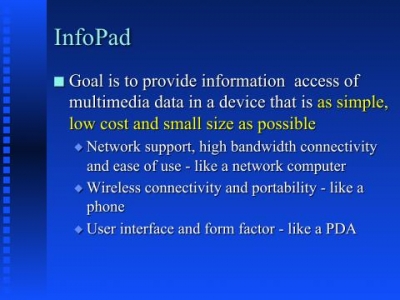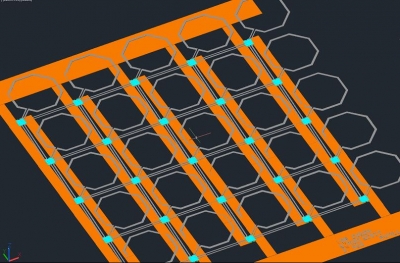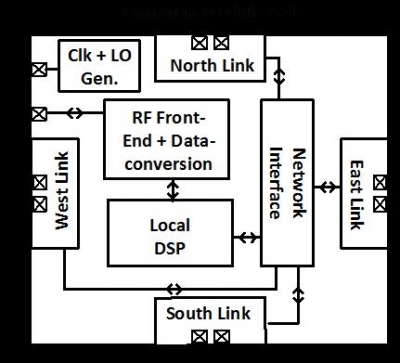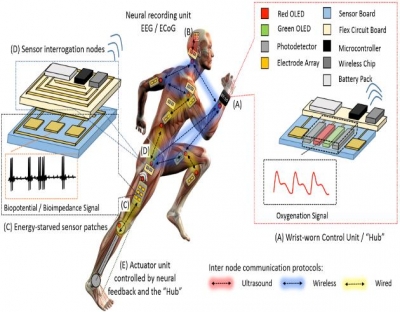Ajith Amerasakera, Executive Director at BWRC
Published: 1 May 2016

CTN Issue: May 2016
A note from the editor:
In this edition we wanted to take a little step out of the world of 5G and air interfaces and take a look at the technology that will, at the end of the day, give us a reason to want all of this new wireless capability. Ajith Amerasekera from the Berkeley Wireless Research Lab has kindly put together a selection of technologies that they are developing that he believes will be critical to the use of 5G and maybe beyond, including some that you may need a little outpatient surgery to take advantage of. I'm sure there are many other ideas in labs out there so comments and suggestions are welcome, as usual.
Flexible Electronics and Human Interfaces: Beyond 5G Technology from the Bleeding Edge at BWRC
Ajith Amerasakera, Executive Director at BWRC
Nearly 20 years ago, two UC Berkeley professors, Bob Brodersen and Jan Rabaey, envisioned a world with ubiquitous connectivity using wireless technology. To demonstrate this, they came up with a small portable hub they called the Infopad and built an entire wireless network which the Infopad used to communicate with other devices. The Infopad was the world's first ever wireless multimedia terminal but it required a highly collaborative effort that yielded significant research contributions up and down the stack in wireless network protocols, communications theory, low-power digital design, system design methodology, signal processing, radio architecture, analog RF design and physical packaging. And so the Berkeley Wireless Research Center was born with a mission to create future systems, rather than just future technology. BWRC has continued to push the boundaries of future wireless systems and in this article we hope to get the reader up to speed on what is the bleeding edge for BWRC today.
Working Infopad in 1995: Preceded iPad by 15 years!


![Drawing of InfoPad in the Office - [Bob Brodersen, ISSCC Keynote, 1997]](/sites/default/files/styles/400wide/public/images/2020-2020-02/3_0.jpg?itok=wlLNKuWS)
In trying to address the hard problems that are keeping us from our Jetson like futuristic world we see 5G as one big step. But we will need a lot more than a new standard to enable robust, low latency, and low energy wireless systems.
For instance, massive MIMO with directional wireless transmission requires a sea of antennas that don’t interfere and this can be prohibitive using standard technology. We are currently developing a printing technology where plastic sheets are used to print arrays of antennas and attach microscopically small chips to preprocess the signals. We could actually just embed this in wallpaper and have antennas everywhere; e-wallpaper! [1]


An e-Wallpaper massive MIMO array of 1GHz to 6GHz antennas with embedded 65nm CMOS chips (in blue) and power lines (orange). The circuit block diagram is on the right. The first version of this chip is in the lab now.
The next generations of this technology will use 28nm CMOS to extend the frequency into the E-Band range enabling the antennas to shrink, reduce power and make the footprint even more compelling.
Beyond the delivery of massive data rates, new technology is required to effectively utilize these bits in a way that consumers will be willing to pay for. We need to provide a human-machine interface that enables this ubiquitous connectivity to be utilized effectively. At the BWRC we are very interested in the last few meters of communication and we call this the Human Intranet.

The Human Intranet: Empowered Humans in an Augmented World. Pushing the limits on miniaturization, ultra-low energy, integration, packaging.
The vision is an integrated wearable network for enhancing health, performance, and brain-machine interfaces, with many applications from medical/wellness, to prosthetics, human augmentations (think Iron Man suits), and seamless human-machine interactions. But now we have additional challenges to address:
- True integration of energy and information distribution
- Global and distributed system intelligence
- Inherently Failsafe operation
- The human firewall
At BWRC we are working on a project called neural dust [2] where small micromotes in our skull cavities can monitor and transmit to external hubs, and to neuromodulators with high-density cortical and sub-cortical electrode arrays; ultra-low power electronics for stimulation and recording on up to 512 channels.
These are enabled by advances in flexible electronics, wearable electronics, implantables and MEMS that are being worked at the BWRC and by collaborators in Berkeley and elsewhere, including flexible and novel battery technology [3]. The components of a battery—the current collectors, active layers, and separator—can all be deposited using conventional printing techniques by designing suitable inks. A combination of low thickness of printed electrodes, flexible packaging, battery architecture, and material properties makes printed batteries flexible. The batteries are printed on a silver coated fabric using Zn and MnO2. They are stretchable (up to 150%) and still able to power a set of LEDs as shown in figure below right. with a capacity of 4mAhcm-2. Below left, we show a wearable application for monitoring health parameters built using flexible electronics including organic LEDs.
We believe that the future of wireless, 5G and beyond, will be driven by application technology and that this kind of technology is being driven today in labs such as the BWRC. Just as the Infopad heralded the ubiquitous touch screen terminals of today, so some of the work we mention in this article will lead to the next must have technology 20 years from now.
References
- Proc. IEEE, March 2016
- MIT Technology Review, July 2013.
- A. M. Zamarayeva, A. M. Gaikwad, I. Deckman, M. Wang, B. Khau, D. A. Steingart, and A. C. Arias, “Fabrication of a High-Performance Flexible Silver–Zinc Wire Battery,” Advanced Electronic Materials, 2016.
- Claire M. Lochner, Yasser Khan, Adrien Pierre, Ana C. Arias "All-organic optoelectronic sensor for pulse oximetry", Nature Communications 5, December 2014
- A. M. Gaikwad, A. C. Arias, and D. A. Steingart, “Recent Progress on Printed Flexible Batteries: Mechanical Challenges, Printing Technologies, and Future Prospects,” Energy Technology, 2015.
Statements and opinions given in a work published by the IEEE or the IEEE Communications Society are the expressions of the author(s). Responsibility for the content of published articles rests upon the authors(s), not IEEE nor the IEEE Communications Society.


